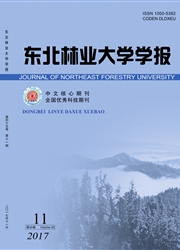

 中文摘要:
中文摘要:
以我国特有较耐腐树种杉木为研究对象,利用彩绒革盖菌(Coriolus versicolor(L.)Quél)和密粘褶菌(Gloeophyllum trabeum(Pers.)Murrill)分别对抽提前后杉木心边材侵染1个月。结果表明:密粘褶菌对杉木木材半纤维素的分解能力要强于彩绒革盖菌,彩绒革盖菌稍具分解木质素和纤维素的能力,而密粘褶菌对木质素和纤维素的分解能力不明显。苯醇抽提处理降低了彩绒革盖菌对木质素和纤维素的分解能力,提高了彩绒革盖菌对综纤维素和半纤维素的分解能力,降低了密粘褶菌对综纤维素和半纤维素的分解能力。杉木木材经两种木腐菌处理1个月后,其纤维形态无显著变化。
 英文摘要:
英文摘要:
With the fir in China,we used Coriolus versicolor( L.) Quél and Gloeophyllum trabeum( Pers.) Murrill to extract the infected sapwood and heartwood for a month. G. trabeum had a stronger capacity to break down hemicellulose than C. versicolor which had a slightly capacity to break down xylem and cellulose,while G. trabeum did not have an obvious capacity to break down them. The capable of decomposing xylem and cellulose was decreased,and that for holocellulose and hemicellulose was increased by C. versicolor,while that for holocellulose and hemicellulose was decreased by G. trabeum. For the fiber morphology,there was no distinct change after infected by two wood-rotting fungi.
 同期刊论文项目
同期刊论文项目
 同项目期刊论文
同项目期刊论文
 期刊信息
期刊信息
